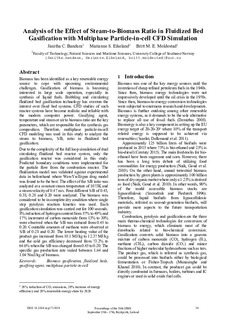| dc.contributor.author | Bandara, Janitha | |
| dc.contributor.author | Eikeland, Marianne Sørflaten | |
| dc.contributor.author | Moldestad, Britt Margrethe Emilie | |
| dc.date.accessioned | 2017-10-12T11:31:32Z | |
| dc.date.available | 2017-10-12T11:31:32Z | |
| dc.date.created | 2017-10-11T13:34:30Z | |
| dc.date.issued | 2017 | |
| dc.identifier.citation | Linköping Electronic Conference Proceedings. 2017, (138), 54-59. | nb_NO |
| dc.identifier.issn | 1650-3686 | |
| dc.identifier.uri | http://hdl.handle.net/11250/2459899 | |
| dc.description.abstract | Biomass has been identified as a key renewable energy source to cope with upcoming environmental challenges. Gasification of biomass is becoming interested in large scale operation, especially in synthesis of liquid fuels. Bubbling and circulating fluidized bed gasification technology has overrun the interest over fixed bed systems. CFD studies of such reactor systems have become realistic and reliable with the modern computer power. Gasifying agent, temperature and steam or air to biomass ratio are the key parameters, which are responsible for the synthesis gas composition. Therefore, multiphase particle-in-cell CFD modeling was used in this study to analyze the steam to biomass, S/B, ratio in fluidized bed gasification. Due to the complexity of the full loop simulation of dual circulating fluidized bed reactor system, only the gasification reactor was considered in this study. Predicted boundary conditions were implemented for the particle flow from the combustion reactor. The fluidization model was validated against experimental data in beforehand where Wen-Yu-Ergun drag model was found to be the best. The effect of the S/B ratio was analyzed at a constant steam temperature of 1073K and a steam velocity of 0.47 m/s. Four different S/B of 0.45, 0.38, 0.28 and 0.20 were analyzed. The biomass was considered to be in complete dry condition where single step pyrolysis reaction kinetics was used. Each gasification simulation was carried out for 100 seconds. 8% reduction of hydrogen content from 57% to 49% and 17% increment of carbon monoxide from 13% to 30% were observed when the S/B was reduced from 0.45 to 0.20. Countable amounts of methane were observed at S/B of 0.28 and 0.20. The lower heating value of the product gas increased from 10.1 MJ/kg to 12.37 MJ/kg and the cold gas efficiency decreased from 73.2% to 64.6% when the S/B was changed from 0.45 to 0.20. The specific gas production rate varied between 1.64 and 1.04 Nm3/kg of biomass. | nb_NO |
| dc.language.iso | eng | nb_NO |
| dc.rights | Navngivelse-Ikkekommersiell 4.0 Internasjonal | * |
| dc.rights.uri | http://creativecommons.org/licenses/by-nc/4.0/deed.no | * |
| dc.title | Analysis of the effect of steam-to-biomass ratio in fluidized bed gasification with multiphase particle-in-cell CFD Simulation | nb_NO |
| dc.type | Journal article | nb_NO |
| dc.type | Peer reviewed | nb_NO |
| dc.description.version | publishedVersion | nb_NO |
| dc.source.pagenumber | 54-59 | nb_NO |
| dc.source.journal | Linköping Electronic Conference Proceedings | nb_NO |
| dc.source.issue | 138 | nb_NO |
| dc.identifier.doi | 10.3384/ecp1713854 | |
| dc.identifier.cristin | 1503802 | |
| cristin.unitcode | 222,58,3,0 | |
| cristin.unitname | Institutt for prosess-, energi- og miljøteknologi | |
| cristin.ispublished | true | |
| cristin.fulltext | original | |
| cristin.qualitycode | 1 | |

